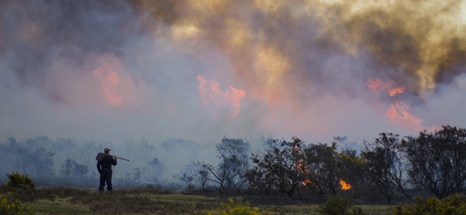 Yearly burning of heather and gorse in the New Forest is helping to reinvigorate the area’s heathland habitats for wildlife, according to a scientific study.
Yearly burning of heather and gorse in the New Forest is helping to reinvigorate the area’s heathland habitats for wildlife, according to a scientific study.
Heathland is a priority for nature conservation in the UK and the New Forest National Park is the largest area of lowland heath in the country.
The Forestry Commission undertakes a programme of controlled burning across the Forest each year. The target for this winter was 304 hectares – about 380 football pitches and 2.5% of the total heathland area across the Crown lands.
Research part-funded by the New Forest Higher Level Stewardship (HLS) Scheme provides scientific evidence that burning does ‘encourage good quality heath, high dwarf shrub cover, low bracken cover, habitat for some heathland specialist invertebrates and, in the early years, open habitat for reptiles and ground active invertebrates1.’
Burning areas of heather and gorse encourages new growth, which benefits a variety of rare plants and wildlife, unique to the area. As gorse regrows it offers cover for heathland birds such as Dartford warbler to breed, as well as providing grazing for New Forest ponies.
The burnt heathland provides a valuable mosaic effect of different aged habitats, which as well as providing diversity also provides effective firebreaks to protect large areas of heathland, woodland and private property from wildfire.
Forestry Commission Open Forest Manager, Dave Morris, said: ‘We had two to three teams of experienced burners, who worked to complete as many burns as possible in the short time available. There were as many as ten controlled burns a day across the New Forest during the recent window of dry weather. Open burns across the forest may look alarming to passers-by, but the controlled nature and planned programme of works have real benefits for the forest environment.
He added: ‘Heathland is a low nutrient habitat and needs to be maintained. Otherwise, the vegetation would rot and decay in-situ, returning nutrients to the soil which would affect and ultimately destroy the delicate balance of our heathlands. The wildlife and vegetation actually benefit from the Forestry Commission’s involvement. For example, heathland birds, such as woodlarks thrive on newly bare ground and reptiles and insects benefit from the ‘edge’ effect that is created. What looks to so many like the ‘natural’ heathland of the New Forest is actually a habitat that has been managed for hundreds of years by our intervention.’
The HLS scheme is an agreement with Natural England, held by the Verderers and managed by them in partnership with the Forestry Commission and the New Forest National Park Authority.
-ends-
1. Page four, ‘A comparison of the effect of managed burning and vegetation cutting on biodiversity in the New Forest’
By Barbara Smith & John Holland (Game & Wildlife Conservation Trust), Dan Carpenter & Paul Eggleton (Natural History Museum) – part funded by HLS. www.hlsnewforest.org.uk/burningbenefits
Notes to photo editors:
Controlled burning in heathland near Sway in the New Forest. Credit: Henry Szwinto.
Notes to Editors
1. The Forestry Commission is the government department responsible for forestry in Great Britain. It supports woodland owners with grants; tree felling licences, regulation and advice; promotes the benefits of forests and forestry; and advises Government on forestry policy. It manages more than a million hectares (2.5 million acres) of national forest land for public benefits such as sustainable timber production, public recreation, nature conservation, and rural and community development. For more information, visit www.forestry.gov.uk/newforest
2. The Environmental Stewardship Schemes, of which HLS is one strand, are administered by Natural England, on behalf of Defra, and funds farmers and land managers throughout England to deliver effective environmental management on their land.
The objectives of Environmental Stewardship are to:
- Promote public access and understanding of the countryside
- Maintain and enhance landscape quality and character
- Protect the historic environment and natural resources
- Conserve biodiversity.
3. The role of the Verderers of the New Forest is to protect and administer the New Forest’s unique agricultural commoning practices; to conserve its traditional landscape, wildlife and aesthetic character, including its flora and fauna, peacefulness, natural beauty and cultural heritage; and to safeguard a viable future for commoning. www.verderers.org.uk
4. Natural England is the government’s advisor on the natural environment. Established in 2006 our work is focused on enhancing England’s wildlife and landscapes and maximising the benefits they bring to the public. www.naturalengland.org.uk
5. The New Forest National Park Authority works with partners to conserve and enhance the natural beauty, wildlife and cultural heritage of the National Park and to promote opportunities for understanding and enjoyment of its special qualities. It also has a duty to foster the social and economic well-being of local communities within the Park. www.newforestnpa.gov.uk
Media Contacts
Esta Mion,Communications Manager, Forestry Commission, Queens House, Lyndhurst, Hampshire, SO43 7NH, Mobile: 07900 137 957, Email: esta.mion@forestry.gsi.gov.uk
Matt Stroud, Matt Stroud, Interpretation and Engagement Officer, New Forest Higher Level Stewardship Scheme, Direct line: 01590 646650, email: matt.stroud@newforesthls.org